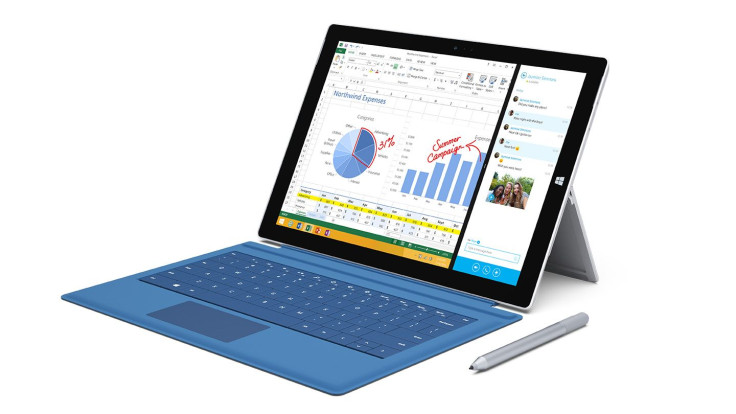Microsoft Surface Pro 3, Apple iPad Air, MacBook Air Comparison: How A Crossover Tablet Stacks Up Against The Competition

The end of the tablet as we know it is here, Microsoft declared on Tuesday when it introduced the Surface Pro 3, the first true crossover device that combines a laptop with a tablet.
So, just how does the “tablet that can replace your laptop,” as Microsoft calls it, stack up against the iPad Air and the MacBook Air?
Let’s break down the specs.
The Surface Pro 3 beats the underpowered iPad Air, but it's similar to the MacBook Air. Both the Macbook Air and the Surface Pro 3 can be configured with an Intel Core i7 Haswell chip with up to 8 GB RAM, both have “all day” batteries and both have up to 512 GB of storage. However, the Surface Pro 3 costs about $200 more than the Macbook Air.
So what does that extra money get you? Portability? Not really. The Surface Pro 3 is slightly lighter, weighing 2.42 lbs. with a keyboard, whereas the MacBook Air is 2.96 lbs. Does the Surface Pro 3 have more peripheral ports? Nope. The MacBook Air has two USB 3.0 ports, an SD card reader and a display port. The Surface Pro 3 has a full-size USB 3.0 port, an SD card reader, and a display port.
Does the Surface Pro 3 have a better screen than the MacBook Air? Yes, at least for now. But to the average naked eye, these devices have brilliant and crisp displays, and the difference is purely technical. The SP3 uses a 2160x1440, 216ppi multi-touch screen. However, the MacBook Air is due for a refresh, which may happen in about two weeks. And the iPad Air already has a better screen (a 2048x1536, 264ppi multi-touch), although it's only 9.7 inches instead of 12.
What the Surface Pro 3 really has to offer over its competition is the convenience of a dual-function device. The iPad Air is mostly used to consume information and media, not create it.
However, Apple has been showcasing the functionality of its mobile line recently, demonstrating how to create videos and commercials that are shot and edited on the iPhone 5s and the iPad Air. The MacBook Air was created to bridge the gap between iPad tablets and the high-end MacBook Pro line, and it has grown into a highly sophisticated computer.
Microsoft sees the two-device paradigm as one device too many. The Surface Pro 3 comes with a pen that allows users to draw, write and manipulate screen items in a more precise way than a finger can on a touchscreen. And with the addition of “palm block” technology, users can rest their hands on the screen when writing, making the pen use feel very natural.
But while Microsoft’s new device may be competitive with the MacBook Air, Apple’s software ecosystem is far superior. Its two operating systems, iOS and OSX, work together seamlessly, whereas Microsoft is still developing its software environment. Windows comes in four flavors: Windows 8, 8 Pro, RT and Phone, and they interact clumsily. If the crossover device category catches on with a growing number of customers who want a consolidated device, advances in the cloud and OTA syncing could improve the dreary experience that currently is Windows 8.
Finally, while buying a single device that has some pretty impressive specs may be a wise decision, many people believe that owning an Apple device brings some clout. Apple is hip, Apple is cool. Microsoft just doesn’t have that cachet, at least not yet. But the Surface Pro 3 is a move in the right direction.
The specs for the three devices are below.
© Copyright IBTimes 2024. All rights reserved.











